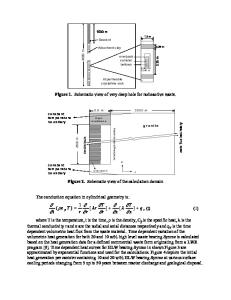Microbial Effects on the Radionuclide Transport in a Deep Nuclear Waste Repository
- PDF / 466,427 Bytes
- 6 Pages / 414.72 x 648 pts Page_size
- 38 Downloads / 292 Views
MICROBIAL EFFECTS ON THE RADIONUCLIDE TRANSPORT IN A DEEP NUCLEAR WASTE REPOSITORY HERVE SPOR, M. TRESCINSKI and M.F. LIBERT, Department of waste management and disposal, Centre d'Etudes Nucl~aires de Cadarache, 13108 St PAUL LEZ DURANCE Cedex, FRANCE ABSTRACT This study deals with the effects of microorganisms on the transport of radionuclides under deep nuclear-waste disposal conditions. Metabolism of a cellulolytic microorganism is studied. Cellulose, as a carbon source, is representative of nuclear waste. A pilot device allows the study of the general effect of microrganisms. Bioleaching of radionuclides by a fungal culture is performed on columns of clay and cement used as engineered barriers. Cesium and Uranium had been incorporated into matrices prior to the tests. Operating conditions have been choosen according to realistic conditions of a deep repository. The production of organic acids by microorganisms is qualitatively and quantitatively determined. In addition, direct effects of microorganisms (biosorption, bioaccumulation) and indirect effects (complexing agents issued from the diodegradation of cellulose) on the transport and/or retardation of radionuclides are studied.
INTRODUCTION A survey of the literature indicated that microorganisms are present in deep geological environments. Microbial activity is well adapted to the extreme conditions of a repository. In a nuclear waste deep repository, the presence of radionuclides and microbiological activity induce environmental modifications that need to be evaluated, with the objective being to prevent or minimize any subsequent radionuclide removal. Microbial biomass has a high affinity for actinides elements, heavy metals or other radionuclides. Microbial interactions may either restrict or enhance the mobility of specific radionuclides in the environment (Fig. N'., 1). We have made a tentative classification of microbial processes in two categories : 1.
Retardation processes : these interactions decrease the mobility of radionuclides.
A contact of the microorganism with the metal induces surface sorption of the radionuclide at the external surface of the cell wall or within a biofilm composed of extracellular polymers secreted by the microorganisms. Intracellular assimilation phenomena of the metal ion is also observed via active or passive membrane transport mechanisms. Microbial activity leads to the production of metabolites responsible for radionuclide complexation or precipitation (H 2S).
Mat. Res. Soc. Symp. Proc. Vol. 294. ©1993 Materials Research Society
772
z 0 F--
I
_N
Z 0
Q
=3
rF-
0©ý
E 0
EC 0
-o
(--
0
0 3
0 o-c-
~0 0CO
I
0
0
~CZ
K
Q-
-a
0Q_
0)
C-
I
rH-
z
a_
0)
0 Q :30 230
Q)
LUJ 0
05 F
.2 Q) 0
UT
U-j
0
QL,
0 -
Co
C (93
c "5.
(9 II LU
w
m1
U)
aI 0
.2.
Zcn
"o0 0 C
eLU
.0
7C3
CQ
\i co
p
0)
2.
2
773
DEEP STORAGE OF RADIOACTIVE WASTES
2.1 BIOLEACHING OF RADIONUCLIDES
deep water
mineral solution
titt -•
engineered barriers clay and/or cement
Cellulose + microorganisms
D
Data Loading...











